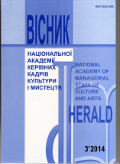ЄВГЕН СТАНКОВИЧ. ПОЕМА-КОНЦЕРТ ДЛЯ СКРИПКИ ТА ОРКЕСТРУ: АВТОРСЬКІ ПРИЙОМИ ТЕМБРОВОЇ ДРАМАТУРГІЇ
Poem-Concert for violin and orchestra: author’s methods of tone colors of dramatic line
Author(s): Yevheniya SirenkoSubject(s): Fine Arts / Performing Arts, Music
Published by: Національна академія керівних кадрів культури і мистецтв
Keywords: Color voice; The main theme; Poem; Concert; Dramatic line;
Summary/Abstract: This article is dedicated to Yevhen Stankovych, a famous Ukrainian composer of modernity. Yevhen Stankovych was born in 1942 in Svaliava (Transcarpatian Region, Ukraine). His works are the recipients of several awards, among which is his Chamber Symphony № 3 that was selected by UNESCO’s World Tribune as one of 10 best works of 1985. The composer’s works have been performed in Canada, the U.S.A., Germany, France, Switzerland, Finland, Spain, China, the Filipines and Yugoslavia and his works have been recorded on Melodiya, Analekta, ASV and Naxos labels.In this article "The Poem-Concert for violin and orchestra" is viewed in details for the first time. The composition was written in 2004 and it was the year of it's premiere at Taras Shevchenko National Opera House of Ukraine, performed by Dmytro Tkachenko (violin) and Ukrainian National Symphony Orchestra conducted by Volodymyr Sirenko. This composition is remarkable for its very unusual and interesting instrumental team: Violino solo, Percussion (Timpani, 5 Temple blocks, 4 Tom-toms, Campanelli, Tam-tam, Vibrafono, Marimba, Wind chimes, Piattosospeso, Gran cassa), Corno, Arpa and string orchestra. Violin is the voice of hero, striking with lyrical and dramatic content. Timpani is the voice of fate and Corn is the voice of truth that gives a lyrical and philosophical conclusion to the whole art composition and has a separate status in the dramatic art overall. Unusual combination of instruments in the Poem-Concert gives to performing ensemble its own structure and detects solo instruments in addition to Timpani and Corn, a basic violin solo. Timpani has significant melodiousness and Corn appears only at the end of the composition carrying out fundamentally new musical material. So, we can say that this composition’s music idea is mainly built by certain tone colors combinations, contrasts of tone colors, matching tone colors and because of content given to these tone colors by author. That is to say the connection of scenario development with tone colors changes and tone colors combinations is particularly prominent.At the heart of the dramatic composition development arises a conflict that is presented in details in the beginning and is a genetic feature of all is the composition’s tone colors. This is a conflict of timpani and violin, rhythmic conflict within the theme, conflict of manner of execution of material – solo and orchestra, genre and intonation conflict – recitation and arioso. Overall figurative and emotional composition development is directed from the imperative statement of the main theme to the gentle lyrical image of the final and relatively enlightened image of Coda.Violin compositions by Stankovych are characterized by a combination of various genres, overlay, intersection, etc. In this composition, author states in the title used basic genre models – Poem and Concert. Features of Poem are manifested primarily in the form of composition, its softened, imperceptible transitions between parts, lasting for a couple of measures. In other words, there is no formal, clear structure. And second unquestioning feature of Poem is the monothematic principle that is very convincing in this composition. Features of concert-like are determined primarily by the presence of violinist, the leading solo party and appropriate differentiation among orchestral groups.It can be declared that Stankovych is a modern tonal composer who uses within one composition different types and models of tonalities that agree with individual instruments and certain way: the more complex with simpler, the more modern with classic. Timpani themes and violin solo inherent complex tone colors of chromatic nature and horn theme is distinguished by a classic D-dur mode.Composition form may have several interpretations but the author himself defines the form as "chain", consisting of seven major episodes that are continuously connected. Also it is possible to interpret the first part as the sonata’s form. Composition’s themes are developed in two main directions: 1) modification of the main construction (the original topic); 2) the introduction of a new, contrasting thematic material. Also there are two main types of themes: 1) "laconic", 2) "singable" and composer integrally combines them in the Poem-Concerto where intro the theme of Timpani is basis. Its elements and rhythmic formulas are present in all episodes of composition. Using various means of intonation renewal, including polyphonic, they develop intensively. In the end of composition the main theme is confronted by a completely different thematic model: light and lyrical theme with brightly evinced cantillation and"endlessness" of sound. We can distinguish three main thematic complexes of this composition: 1) the theme of Timpani– "the call of fate"; 2) the monologues of Violin – lyrical reflection; 3) the solo of Corn – "the voice of truth".So, the Poem-Concert for Violin and Orchestra by Y. Stancovych is a significant composition in modern Ukrainian violin and symphonic music. This opus encourages listener to focus on his own soul and deep inner feelings, it’s the art in which Yevhen Stankovych, the composer and philosopher is fluent in.
Journal: Вісник Національної академії керівних кадрів культури і мистецтв
- Issue Year: 2014
- Issue No: 3
- Page Range: 225-229
- Page Count: 5
- Language: Ukrainian

